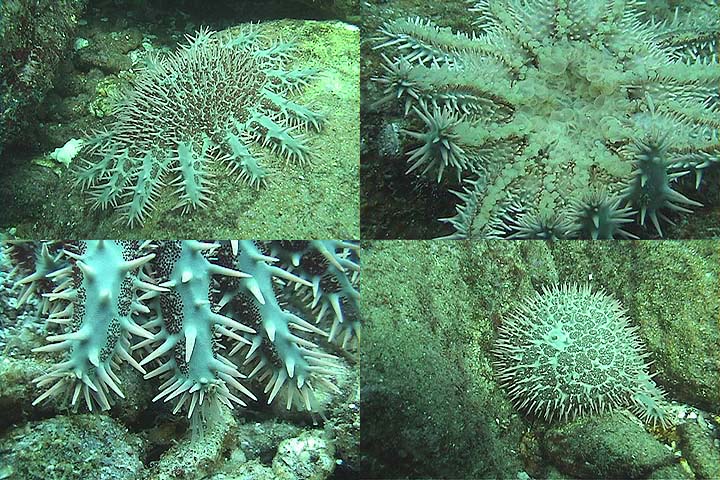| diver.net |
| COT sea stars attack Catalina dive park |
[ Follow Ups ] [ Post Followup ] [ California Scuba Diving BBS ] [ FAQ ]
| diver.net |
| COT sea stars attack Catalina dive park |
|
Posted by Dr. Bill Bushing on April 01, 2006 at 17:48:49:
 It was bound to happen. Trans-Pacific shipping into Los Angeles has seen the importation of exotic marine life of a number of different species to Santa Catalina Island and southern California from the Indo-Pacific region. These include the Japanese sea fern (Sargassum muticum) several decades ago and more recently Undaria pinnatifida, formerly a Japanese endemic brown alga that has been introduced in a number of places world wide. Both of these exotics have the potential to outcompete our native giant kelp (Macrocystis pyrifera), and efforts to eradicate them (especially the latter) are underway. Many of you have heard of the Indo-Pacific sea star known as the crown of thorns (Acanthaster planci), often abbreviated as COT. Even in regions where it naturally occurs, this sea star is known to undergo inexplicable population explosions. In regions where it is not native, COT sea stars often multiply to great numbers in the absence of any predators. These starfish feed on cnidarians (formerly referred to as coelenterates) such as hard corals and have done great damage to tropical coral reef habitats. Today, while diving in the Casino dive park in Avalon, I observed several crown-of-thorns sea stars on our rocky reefs. There are no typical reef-building hard corals here to feed on. Instead, these sea stars appear to be feeding on our solitary and colonial cup corals. Should they increase substantially in number, it is possible they could easily wipe out these native species. Therefore it is extremely important to get rid of these exotic marine animals before they do irreparable harm to our Catalina and southern California cup coral populations. The image below is of the COT sea stars I discovered earlier today during my dives in the dive park. If you see this sea star in Catalina waters, or on the southern California mainland, it is essential that they be rendered non-reproductive. PLEASE do NOT try to crush them in the water. Doing so usually results in creating fragments which can then each regenerate a new sea star in time. Therefore, to try to kill them this way usually results in increasing the local population and thereby worsening the problem. Carefully pick them up and place them in your goody bag. Use caution since the spines of the COT can easily penetrate even a gloved hand and cause significant pain. Once back on land, dispose of these sea stars by burning them or drying them out completely in the sun, then discard them in the trash. They are NOT recycleable so place them in your normal trash bins. If you have any questions about these sea stars and how to deal with them, please feel free to contact me (Dr. Bill) by replying to this e-mail. APRIL FOOLS!!! |
Follow Ups:
|
| Name: | |
|---|---|
| E-Mail: | |
| Subject: | |
| Message: | |
| Optional Link URL: | |
| Optional Link Title: | |
| Optional Image URL: | |
| Post Background Color: | White Black |
| Post Area Page Width: | Normal Full |
| You must type in the scrambled text key to the right. This is required to help prevent spam bots from flooding this BBS. |
|
| Text Key: |